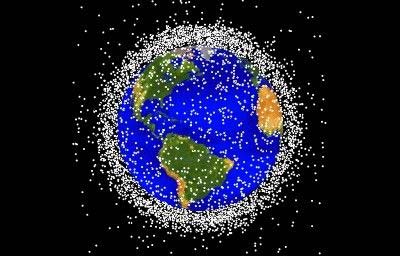Space debris: not just an American problem?by Taylor Dinerman
|
| At this time, the consensus is that “…man made space debris poses little risk to ordinary unmanned spacecraft in Low Earth Orbit (LEO).” |
The proposed measures include reducing debris released during normal space operations, mitigating on-orbit breakups, and insuring end-of-life safety on all spacecraft. In order to comply with these last two requirements, satellites have to be designed so that the fuel tanks of their attitude and station-keeping thrusters, and other propulsion systems, are fully emptied before they can be considered properly disposed of. This is an expensive process, especially if done with a very high degree of certainty.
US regulations are intended to insure that US-built satellites fulfill these guidelines. While other spacefaring nations have promulgated their own standards for debris mitigation, there is, as of now, no international consensus position on this problem. The IADC has proposed some non-binding guidelines. Similar non-binding agreements have, in the past, been useful on subjects such as remote sensing, direct television broadcasting, and nuclear power sources. In each case, the US has taken the lead in forging the agreement with the members of the UN’s Committee On the Peaceful Uses of Outer Space (COPUS).
Apparently there is some resistance inside the US Department of Defense to the acceptance of this agreement. Without full support of all the US government’s spacefaring agencies, the IADC guidelines are not going to be adopted. On one level, this is a reasonable attitude. The Pentagon wants to be able, at some future date, to develop and deploy systems that can destroy enemy satellites by kinetic energy (KE) interceptors. The problem of debris mitigation might also create problems for missile defense system tests.
Fortunately, anti-satellite weapons technology is moving beyond the simple KE systems of the past. However, if the US were to suddenly need a satellite killer within say, a 24-month time frame, a KE a-sat would be the only way to go. Newer systems include high-powered jammers and, eventually, high-powered microwaves or other beam weapons that could incapacitate a satellite without breaking it up.
The Ground Based Missile Defense (GMD) system, which is currently being deployed with interceptor missiles based in Alaska and California, will be tested at altitudes too low to create a space debris problem. Future terminal- and boost-phase missile defense systems will also hit their targets within close range of the Earth’s atmosphere. In the case of boost-phase weapons, the debris will fall back on the nation that launched the missile. It should also be very clear that, given the choice between debris in space and a nuclear warhead falling on a US city, no US leader would hesitate for a nanosecond. In fact, the same holds true for any nation with a moderately sane leadership.
| Without the guidelines, the problem of keeping Earth orbit relatively clean is a burden that falls mostly on the US and, to some degree, on Europe as well. |
One problem that the Pentagon and industry both face is the added expense of insuring that functional satellites can be “passivated” at the end of their useful lives. One interesting technical solution to at least part of this problem is to use the Teflon-stick fueled Pulse Plasma Thrusters (PPT), which were tested on NASA’s experimental remote sensing satellite Earth Observing 1 (EO-1), launched in 2000. Since there are no fuel tanks, the systems allow designers to get around the need to put complex tank venting systems on their spacecraft. This technology is well understood and could radically reduce the cost of compliance with the US, and future international, debris mitigation guidelines.
Without the guidelines, the problem of keeping Earth orbit relatively clean is a burden that falls mostly on the US and, to some degree, on Europe as well. The adoption of the proposed IADC Non-Binding Principles on Debris Mitigation would go a long way towards creating a level playing field for the US space industry. All spacefaring nations have a shared interest in the safety of their spacecraft in Earth orbit, so this should be a fairly easy subject on which to reach consensus.
In fact, if such guidelines are put in place, gravity and the small wisps of atmosphere which reach out into LEO will insure that, over the years, things will only get better for that region of space. The proposed methods of safeguarding geosynchronous orbit is more complex, but should not be too burdensome. The future problems may lie in between, in what is called medium Earth orbit, and there, a future fleet of space-based cleaning robots might some day be a useful investment.
